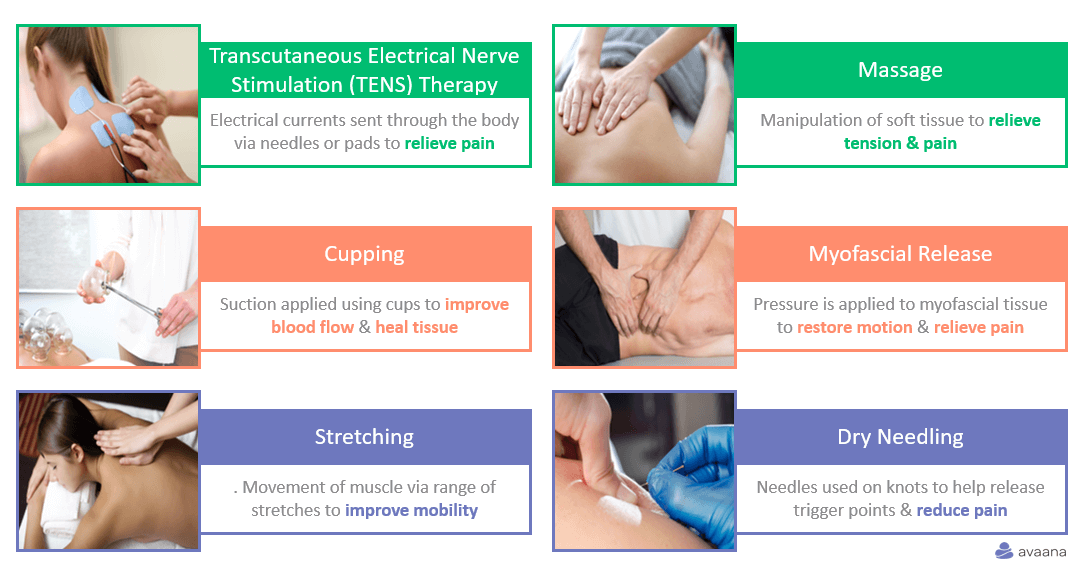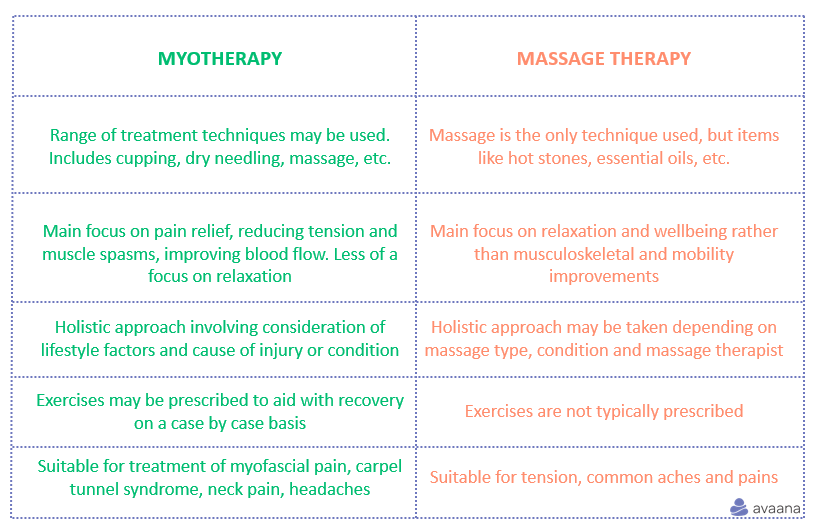Nagging muscle pain, joint stiffness and poor posture. Soft tissue pain is so common…. yet, many of us suffer in silence and neglect getting treatment.
This could, in part, be because you’re unsure which healthcare professional can help. Or, that you don’t know which type of massage therapist is best for you.
If this is the case, you’re in the right place at the right time. You’re about to discover how Myotherapy can ease all types of musculoskeletal conditions. And give you the sweet pain relief you crave.
What is Myotherapy?
Myotherapy helps correct musculoskeletal problems, soft tissue pain, and inhibited joint movement.
It’s a type of physical therapy (like massage) that uses specialised techniques to:
-
assess and treat physical pain
-
nurture the muscles and joints
-
release myofascial dysfunction.
Myofascial pain (or dysfunction) is a common, complex condition. The myofascia is a thin connective tissue that surrounds your muscles. It can feel tight and painful if there’s irritation or inflammation in the area. For example, you could have myofascial pain if you lift something heavy and still feel muscle pain weeks later. In this instance, myotherapy trigger point release could help you feel better.
Different types of Myotherapy Techniques
Myotherapists have a wide range of techniques in their treatment toolbox.
To determine which is best for you, they’ll note your medical history and use assessment techniques. These will help create an individualised treatment plan to suit your needs.
Your practitioner may use some of the following techniques:
Remedial Massage
Remedial techniques and, sometimes, sports massage techniques are used. They manipulate the soft tissues and muscle fibres to relieve acute and chronic pain.
Passive Stretching
Involves moving the muscles in different directions using external force. It’s a great way to improve range of motion and ease joint pain. Note that this is different to active stretching and dynamic stretching. These are more useful during exercise warm ups to aid injury prevention.
Myofascial Trigger Point Therapy
A soft tissue muscle therapy that releases painful fascia and muscle tension. It’s excellent for releasing uncomfortable knots in muscle tissues. This type of muscle medicine combines:
- deep and soft tissue massage
- dry needling (using acupuncture needles)
- cold therapy (may include ice packs)
- ischemic compression.
Myofascial Cupping
Involves special cups that apply suction to the sore area. This helps improve blood flow and restore muscle function.
TENS Therapy
Officially called Transcutaneous Electrical Nerve Stimulation (TENS) therapy. This device sends electrical currents through the body to relieve musculoskeletal pain.
Muscle Energy Technique (MET)
Uses the neurological reflexes to stretch myofascial tissue. It helps mobilise joints, reduce pain, and improve blood & lymph flow.

What is the difference between Myotherapy and Massage?
Myotherapy and massage therapy are not the same thing.
Yes, both of them help to:
-
treat soft tissue aches and pains
-
improve movement efficiency
-
nurture musculoskeletal injuries.
They also both use massage as a therapeutic tool. Despite their similarities, they actually serve different purposes.
Myotherapy uses a range of techniques to improve functional movement, including myotherapy massage. This allows it to treat complex conditions – more than massage alone is capable of. It’s great for providing relief from pain and reducing muscle tension. Myotherapy considers lifestyle factors and the cause of your injury or condition. This ensures treatment doesn’t make your condition worse. A myotherapist can also provide an exercise prescription.
This is in contrast to massage.
Massage therapists only use massage techniques to support the musculoskeletal system. Giving pain relief and improving muscle pain is often secondary to relaxation. However, this varies depending on the type of massage you choose. A massage therapist is not qualified to give corrective exercises.

What’s the difference between Myotherapy and Physiotherapy?
Myotherapy and Physiotherapy use similar techniques to support musculoskeletal health. However, there are some key differences.
Physiotherapists are recognised by the Australian Department of Health. They often work in hospitals and are qualifiedto diagnose conditions. Physios can support physical rehabilitation and patients pre- and post- surgery. Providing an exercise program is an important part of their role.
This is a little different to myotherapists, who generally don’t work in hospitals. They’re also not qualified to provide a diagnosis. Myotherapists usually prioritise a more hands-on, direct approach.
What can Myotherapy help with?
Myotherapists know how to optimise your body mechanics. This can provide effective relief and promote healing in the following conditions.
- Muscular pain and tension
- Sports injuries, e.g. muscle sprains
- Poor posture
- Stiff joints
- Headaches and migraines
- Overuse injuries, e.g. tennis elbow
- Reducing episodes of injury
- Disk injuries, e.g. herniation
- Degenerative conditions that impact muscles and joints, e.g. osteoarthritis
- Chronic conditions that limit movement, e.g. back pain
- Shoulder impingement syndrome
- Rehabilitation after surgery.
What can I expect from my first Myotherapy appointment?
During an initial assessment, your Myotherapist will be on a fact-finding mission.
They’ll take your thorough case history and ask questions about your:
- physical health
- mental health
- medical history
- current medications
- test results relating to the condition, e.g. x-rays
- long-term health goals.
Yeah, this is a lot of personal info. But rest assured that it be recorded and stored in the strictest confidence.
Your practitioner will also do a physical assessment to identify faulty body mechanics. Depending on your situation, they may:
-
Examine affected joints and associated muscles
-
Test your reflexes
-
Assess your range of movement
-
Check your posture
-
Gently palpate the affected area
-
Use functional tests.
Will Myotherapy treatment hurt?
Myotherapy is not designed to be painful.
Your therapist will use a range of techniques to assist with injury rehabilitation and pain. Some of these may be a little uncomfortable at the time. However, at no point should the treatment be unbearably painful.
Remember that you are always in control of your session. If there’s a manual therapy you’d rather not receive, tell your practitioner. It’s their job to tailor things to your needs.
Ready to get lasting relief from your pain?
Want to waive bub-bye to frustrating muscle fatigue?
Click here to book with a myotherapist near you!
Leave a Reply
You must be logged in to post a comment.




Thanks to this website for bringing comprehensive information to the audience and adding new things to the Internet. Hope to get more of this line of information in future as well.